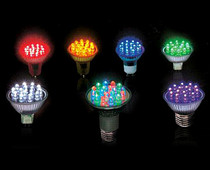
Large-scale adoption of retrofit LED lamps are forecasted to lead to $100 billion in global energy savings over the next five years, according to a recent report from IMS Research based on numerous interviews with leading industry suppliers. Rapid growth in the conversion toward LED lamps for general lighting is expected to generate a market of more than 4 billion units by 2016. Key legislation banning conventional incandescent bulbs in the US and Europe has helped initiate this trend, while consumers are also realizing the long-term savings associated with LED lamps over competitive options such as halogen and compact fluorescent bulbs.
Lighting accounts for approximately 19 percent of the world’s energy use at present, according to most studies. IMS Research forecasts that in 2016 about 15 percent of all lighting on the market will be based on LED technology, which would reduce global energy consumption of lighting by at least 20 percent.
Retrofit LED lamps use a significantly smaller amount of the power of incandescent lamps for the same light output. The IMS report has also stated that the use of retrofit LED lamps in place of incandescent lamps will result in energy savings of more than 30 GW-hr in 2012 and 300 GW-hr by 2016. Altogether, the five-year cumulative total will be more than 800 GW-hr, which would be equivalent to $100 billion in energy savings. Interestingly enough, this annual energy savings would eliminate the need for 50 nuclear power stations at full capacity over that period.
At the consumer level, the benefits of using LED lamps to the general consumer are obvious in the massive reductions in average household energy bills. Currently, it costs the typical US household $20 to purchase and run an incandescent lamp for four hours a day over a year compared to $16 for an LED lamp, which would be a savings of 20 percent. What’s more, an LED lamp has an average life expectancy of over 30,000 hours, which is roughly 30 times longer than an incandescent lamp, making LEDs the cheapest solution over the long-term.
However, price matters up-front; thus, many companies are investigating innovative ways to reduce the cost of LED lamps to make them more affordable to the average consumer. One of the most effective ways to achieve a cost reduction is by fabricating high-quality LEDs on less expensive silicon wafers as opposed to silicon carbide or sapphire ones.
One company, Daewon Innost, based in South Korea, is focused on that goal using proprietary Nano-Pore Silicon Substrate (NPSS) technology. These new innovative arrays were announced this week to possess the industry’s best thermal dissipation performance with thermal impedance of only 0.410C / W. Excessive heating is a problem for LED lamps, as it degrades the overall performance. The Daewon modules run over 12 degrees centigrade cooler than the prior industry benchmark result. In any case, many other technical issues need to be solved in order to make gallium nitride-based LEDs on silicon wafers highly competitive. Nonetheless, for each degree centigrade lower in LED operating temperature, an extra 1000 hours of lifetime can be achieved; thus, extending the reliability and longevity of this emerging green energy lighting technology.





